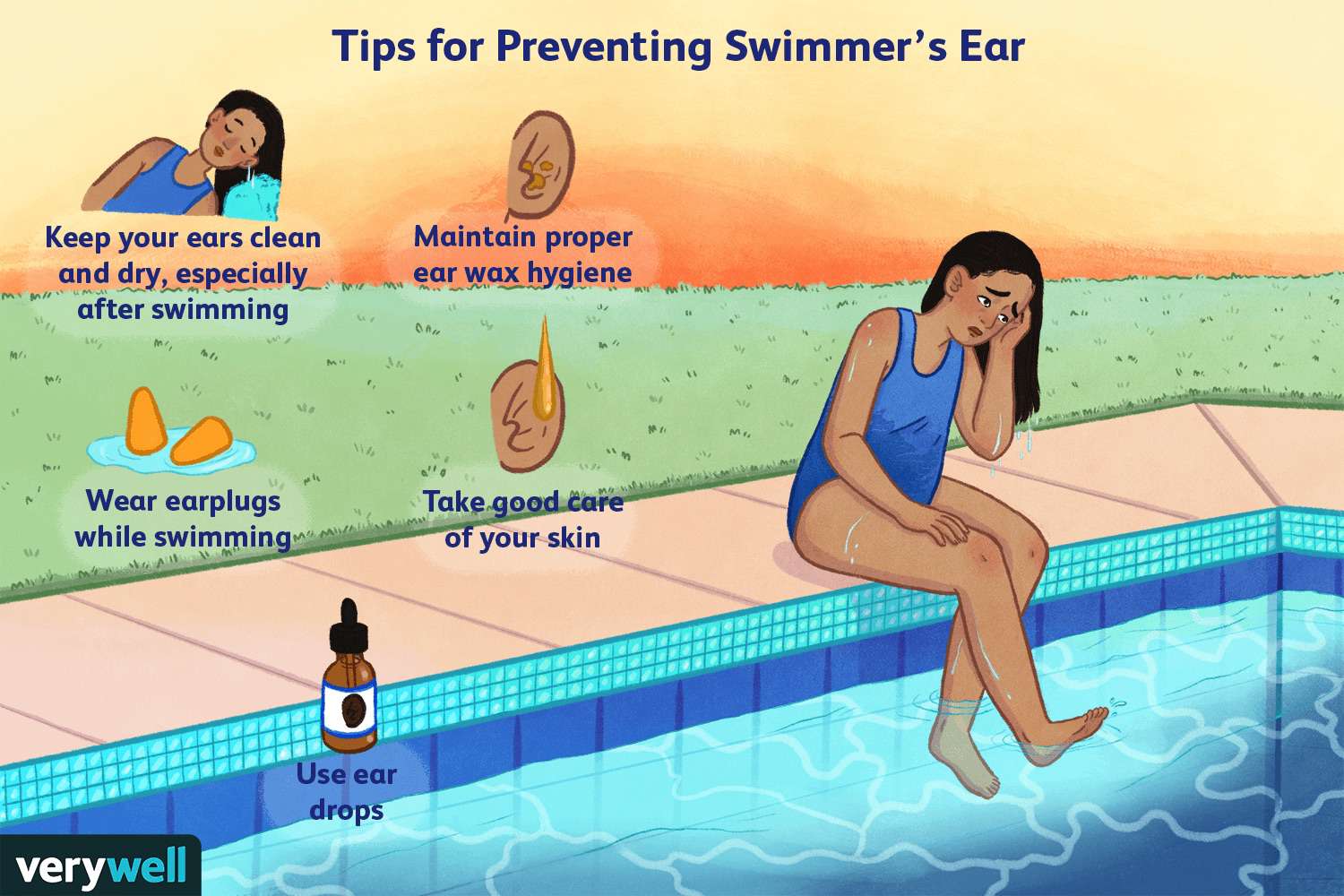
Understanding and Preventing Swimmer’s Ear
-
Table of Contents
“Swimmer’s Ear: Dive in with Confidence, Stay Protected!”
Swimmer’s ear, also known as otitis externa, is a common condition that affects the outer ear canal. It is typically caused by water remaining in the ear after swimming or bathing, creating a moist environment that promotes bacterial or fungal growth. This can lead to inflammation, pain, and discomfort. Understanding the causes and symptoms of swimmer’s ear is crucial in preventing its occurrence. By taking preventive measures, such as keeping the ears dry and clean, individuals can reduce their risk of developing this condition.
Causes and Risk Factors of Swimmer’s Ear
Swimmer’s ear, also known as otitis externa, is a common condition that affects many individuals, particularly those who spend a significant amount of time in the water. It is an infection of the outer ear canal, which can cause pain, discomfort, and even hearing loss if left untreated. Understanding the causes and risk factors of swimmer’s ear is crucial in preventing this condition.
One of the primary causes of swimmer’s ear is excessive moisture in the ear canal. When water gets trapped in the ear, it creates a moist environment that is conducive to the growth of bacteria and fungi. This can occur when swimming or bathing, especially in dirty or contaminated water. Additionally, excessive sweating or high humidity can also contribute to the development of swimmer’s ear.
Another common cause of swimmer’s ear is damage to the skin lining the ear canal. Scratching the ear with sharp objects, such as cotton swabs or hairpins, can cause small cuts or abrasions that allow bacteria or fungi to enter and infect the ear canal. Similarly, inserting objects into the ear, such as earplugs or hearing aids, can also damage the skin and increase the risk of infection.
Certain individuals are more susceptible to developing swimmer’s ear due to various risk factors. People with narrow ear canals or excessive earwax production are more prone to trapping water and creating a favorable environment for infection. Additionally, individuals with compromised immune systems, such as those with diabetes or HIV/AIDS, are at a higher risk of developing swimmer’s ear.
Frequent swimmers, particularly those who swim in pools or hot tubs, are also more likely to develop swimmer’s ear. The chlorine and other chemicals used to disinfect the water can disrupt the natural balance of bacteria in the ear canal, making it more susceptible to infection. Furthermore, individuals who engage in water sports or activities that involve frequent submersion of the head, such as diving or water polo, are at an increased risk of developing swimmer’s ear.
Preventing swimmer’s ear involves taking certain precautions to minimize the risk of infection. One of the most effective preventive measures is to keep the ears dry. After swimming or bathing, it is important to thoroughly dry the ears using a towel or a hairdryer on a low setting. Tipping the head to the side can also help drain any excess water from the ear canal.
Wearing earplugs or a swim cap can provide an additional layer of protection for individuals who frequently swim or participate in water activities. These accessories help prevent water from entering the ear canal and reduce the risk of infection. It is important to ensure that earplugs fit properly and are made of waterproof material.
Maintaining good ear hygiene is also essential in preventing swimmer’s ear. Avoid inserting objects into the ear canal, as this can damage the skin and increase the risk of infection. Instead, clean the outer ear with a washcloth or a cotton ball. If excessive earwax is a concern, consult a healthcare professional for safe removal.
In conclusion, understanding the causes and risk factors of swimmer’s ear is crucial in preventing this common condition. Excessive moisture in the ear canal and damage to the skin lining are primary causes of swimmer’s ear. Certain individuals, such as frequent swimmers or those with narrow ear canals, are more susceptible to developing this condition. Taking preventive measures, such as keeping the ears dry, wearing earplugs, and maintaining good ear hygiene, can significantly reduce the risk of swimmer’s ear. By implementing these strategies, individuals can enjoy their time in the water without the worry of developing this uncomfortable and potentially serious infection.
Symptoms and Diagnosis of Swimmer’s Ear
Swimmer’s ear, also known as otitis externa, is a common condition that affects many individuals, particularly those who spend a significant amount of time in the water. It is an infection of the outer ear canal, which can cause discomfort and pain. Understanding the symptoms and being able to diagnose swimmer’s ear is crucial in order to seek appropriate treatment and prevent further complications.
One of the most common symptoms of swimmer’s ear is ear pain. This pain can range from mild to severe and may worsen when the ear is touched or pulled. It is often described as a sharp, stabbing pain that can radiate to the jaw or neck. In addition to pain, individuals with swimmer’s ear may also experience itching in the ear canal. This itching can be quite intense and may lead to a desire to scratch the ear, which can further irritate the skin and worsen the infection.
Another symptom of swimmer’s ear is a feeling of fullness or blockage in the ear. This sensation is often accompanied by decreased hearing or muffled sounds. The infection can cause swelling and inflammation in the ear canal, which can lead to a buildup of fluid and a sense of pressure. In some cases, individuals may also notice a discharge from the ear. This discharge can be clear, yellow, or even bloody, and may have a foul odor.
Diagnosing swimmer’s ear typically involves a physical examination of the ear by a healthcare professional. The doctor will use an otoscope, a handheld instrument with a light and magnifying lens, to examine the ear canal and eardrum. In cases of swimmer’s ear, the ear canal may appear red, swollen, and inflamed. The doctor may also gently tug on the earlobe or move the tragus, the small, pointed flap of cartilage in front of the ear, to assess for pain or tenderness.
In some cases, the doctor may take a sample of the discharge from the ear for further analysis. This can help determine the specific bacteria or fungus causing the infection and guide treatment decisions. However, this is not always necessary, as the diagnosis can often be made based on the physical examination alone.
It is important to seek medical attention if you suspect you have swimmer’s ear, as prompt treatment can help alleviate symptoms and prevent complications. Without treatment, swimmer’s ear can lead to more serious infections, such as cellulitis or abscesses. Additionally, if left untreated, swimmer’s ear can cause damage to the delicate structures of the ear, including the eardrum.
Preventing swimmer’s ear is key, especially for individuals who are prone to recurrent infections. One of the most effective preventive measures is to keep the ears dry. After swimming or showering, it is important to thoroughly dry the ears using a towel or a hairdryer on a low setting. Tilt the head to the side to allow any trapped water to drain out. It is also advisable to wear earplugs or a swim cap to prevent water from entering the ear canal.
Avoid inserting objects into the ear, such as cotton swabs or bobby pins, as this can damage the delicate skin and increase the risk of infection. If you have a history of swimmer’s ear or are prone to ear infections, consider using over-the-counter ear drops after swimming to help prevent infection. These drops typically contain a mixture of alcohol and acetic acid, which can help dry out the ear canal and create an unfavorable environment for bacteria and fungi.
In conclusion, understanding the symptoms and being able to diagnose swimmer’s ear is crucial in order to seek appropriate treatment and prevent further complications. Ear pain, itching, fullness, and discharge are common symptoms of swimmer’s ear. Diagnosis typically involves a physical examination of the ear, and in some cases, a sample of the discharge may be taken for further analysis. Prompt treatment is important to alleviate symptoms and prevent complications. Preventive measures, such as keeping the ears dry and avoiding the insertion of objects into the ear, can help reduce the risk of swimmer’s ear.
Effective Prevention and Treatment of Swimmer’s Ear
Swimmer’s ear, also known as otitis externa, is a common condition that affects many swimmers. It is an infection of the outer ear canal, typically caused by water remaining in the ear after swimming. This article will discuss effective prevention and treatment methods for swimmer’s ear.
Prevention is key when it comes to swimmer’s ear. One of the most important steps you can take is to keep your ears dry. After swimming, it is crucial to thoroughly dry your ears using a towel or a hairdryer on a low setting. Tilt your head to the side and gently pull on your earlobe to help water drain out. It is also advisable to wear earplugs or a swim cap to prevent water from entering the ear canal.
Another preventive measure is to avoid inserting objects into your ears. This includes cotton swabs, bobby pins, or any other sharp objects. These can damage the delicate skin in the ear canal, making it more susceptible to infection. If you feel the need to clean your ears, use a soft cloth to gently wipe the outer part of the ear.
Additionally, it is important to maintain good ear hygiene. Regularly clean your ears with a mild soap and water solution. Avoid using harsh chemicals or excessive cleaning, as this can disrupt the natural balance of the ear canal and increase the risk of infection.
If you do develop swimmer’s ear, prompt treatment is essential to prevent complications. The first step is to consult a healthcare professional, who will examine your ear and prescribe appropriate medication. Typically, antibiotic eardrops are prescribed to treat the infection. These eardrops contain antibiotics and sometimes steroids to reduce inflammation and relieve pain.
In addition to medication, there are several home remedies that can help alleviate symptoms and aid in the healing process. Applying a warm compress to the affected ear can provide relief from pain and reduce inflammation. Over-the-counter pain relievers, such as ibuprofen or acetaminophen, can also help manage discomfort.
It is important to note that swimmer’s ear can sometimes lead to more serious complications if left untreated. These can include middle ear infections, hearing loss, or even damage to the bones of the ear. Therefore, it is crucial to seek medical attention if symptoms persist or worsen.
In conclusion, swimmer’s ear is a common condition that can be effectively prevented and treated. By following proper preventive measures, such as keeping your ears dry and avoiding the use of sharp objects, you can significantly reduce the risk of developing swimmer’s ear. If you do develop the infection, prompt treatment with antibiotic eardrops is crucial. Additionally, home remedies such as warm compresses and over-the-counter pain relievers can help alleviate symptoms. Remember, if symptoms persist or worsen, it is important to seek medical attention to prevent complications.In conclusion, understanding and preventing swimmer’s ear is crucial for maintaining ear health. Swimmer’s ear is an infection that occurs when water remains trapped in the ear canal, creating a moist environment for bacteria to grow. To prevent swimmer’s ear, it is important to keep the ears dry, use earplugs or a swim cap, and avoid inserting objects into the ear canal. Additionally, practicing good hygiene, such as drying the ears thoroughly after swimming and using a vinegar and water solution to clean the ears, can help prevent this condition. By taking these preventive measures, individuals can reduce their risk of developing swimmer’s ear and maintain optimal ear health.

